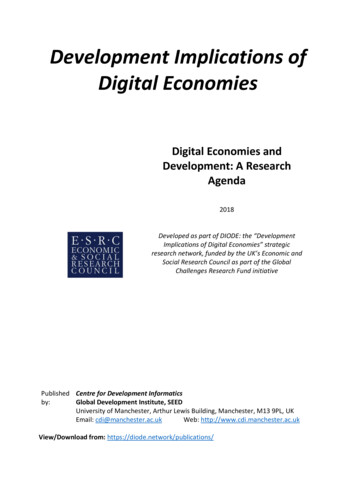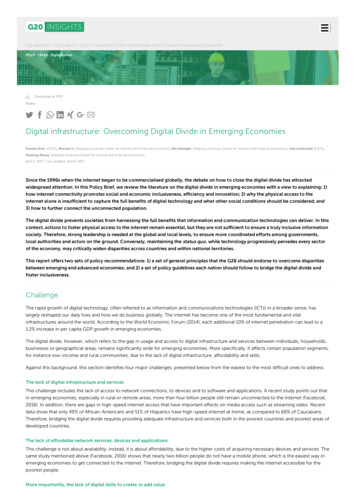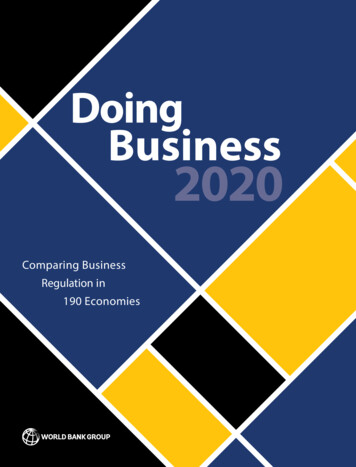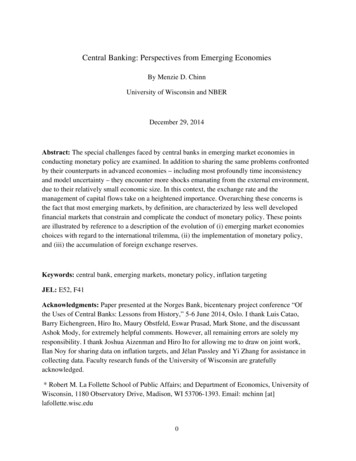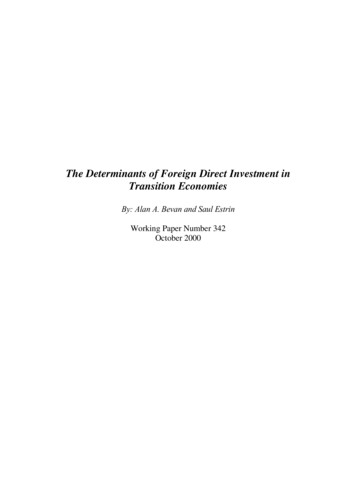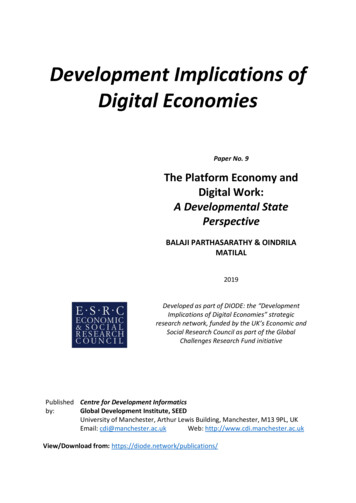
Transcription
Development Implications ofDigital EconomiesPaper No. 9The Platform Economy andDigital Work:A Developmental StatePerspectiveBALAJI PARTHASARATHY & OINDRILAMATILAL2019Developed as part of DIODE: the “DevelopmentImplications of Digital Economies” strategicresearch network, funded by the UK’s Economic andSocial Research Council as part of the GlobalChallenges Research Fund initiativePublished Centre for Development Informaticsby:Global Development Institute, SEEDUniversity of Manchester, Arthur Lewis Building, Manchester, M13 9PL, UKEmail: cdi@manchester.ac.ukWeb: http://www.cdi.manchester.ac.ukView/Download from: https://diode.network/publications/
Table of ContentsABSTRACT . 11. THE PLATFORM ECONOMY AND DIGITAL WORK . 22. THE EXTENT OF DIGITAL GIG WORKERS . 53. THE HISTORICAL RELATIONSHIP BETWEEN TECHNOLOGY AND WORK . 114. THE INDIAN DEVELOPMENTAL STATE, ITS POLICES AND OUTCOMES . 125. POLICY OPTIONS FOR THE DEVELOPMENTAL STATE . 205.1 JURISDICTIONAL CONTROL OVER PLATFORMS . 205.2 PLATFORMS AS PUBLIC GOODS . 215.3 EDUCATION AND SKILLS TRAINING . 226. SUMMARY . 23REFERENCES . 25
The Platform Economy and Digital Work:A Developmental State PerspectiveBalaji Parthasarathy & Oindrila MatilalInternational Institute of Information Technology BangaloreIndia2019AbstractAs advances in information and communication technologies make the platform economyincreasingly important, digital gig work has gained prominence as a source of employment.There are, however, concerns about the implications of new technologies and their socioeconomic manifestations. A primary concern is with the opacity of algorithmic management.Another has to do with the ability of digital gig workers to negotiate their conditions ofemployment since they perform online tasks that individualize work, and they are spatiallyand socially removed from their employers and fellow-workers. There are also concernsabout de-skilling, as much of the digital gig workforce undertakes menial and repetitivetasks.But questions about labor conditions, or the impact of globalization and technologicalchange are not new. In the 20th century, they were addressed by states in the global Southtaking an active developmental role to improve standards of living. It is against thisbackdrop that this paper will use India as a case to examine the continued relevance of thedevelopmental state in the platform economy.The paper will argue that the state continues to have a role in encouraging the demand for,and the building of, platforms within its jurisdiction. This will ensure that the employmentopportunities offered by digital gig work are available, while making it possible to regulatethe employment conditions of workers and the algorithms governing platforms. Alongside,creating a workforce with better and distinct skills will not only help workers gain acomparative advantage but also equip them to improve their position in the internationaldivision of labor.
1. The Platform Economy and Digital WorkIncreasing economic globalization, and the evolution and spread of information andcommunication technologies (ICTs), has given rise to a digital economy comprising “thedigital sector plus emerging digital and platform services” (Bukht & Heeks, 2017:1) (Figure1). Platforms provide “the basic infrastructure to mediate between different groups”(Srnicek, 2017:26) and extract value from the interactions between “those who offerservices and others who are looking for them” (Scholz, 2016:4).1 In the digital economy,platforms have emerged as a new business model, in the form of “online marketplaces thatinvolve at least three parties where the platform provider serves as an intermediarycoordinating supply and demand sides of the other two parties” (Schmidt, 2017:5).2 TheWorld Bank (2015:3) estimated the revenues of the platform economy to be worth US 4.8billion in 2016, and that it could grow up to US 25 billion in 2020.Figure 1: Scoping the digital economySource: Bukht & Heeks (2017:13)The digital work (or “gig” work) that platforms help coordinate can be placed into two broadcategories.3 The first is physical gig work: location-based digital labor or “work on-demand1As infrastructure mediating between different groups, platforms hardly need be digital (Rysman, 2009). Forexample, shopping malls that bring together various stores, and customers seeking different products, areexamples of platforms providing infrastructure that is physical.2There have emerged a number of terms related to the platform economy, such as the sharing economy, orthe on-demand economy (to describe the overall domain), and terms such as online labor, crowd work ordigital labor, to describe the type of work done (Heeks, 2017a).3Srnicek (2017:27-28) classifies digital platforms into four types. The first are advertising platforms, such asFacebook, which use information mined about users as the basis for generating revenues by selling onlineadvertising space. The second are cloud platforms, such as Amazon, which rent out their infrastructure to thirdparties. The third are industrial platforms, such as Siemens, which build the infrastructure to transform2
via apps” including “activities such as transport, cleaning and running errands” and “formsof clerical work channelled through apps managed by firms” (De Stefano, 2016:1).Examples include platforms such as Uber or Airbnb. Srnicek (2017) also refers to theseplatforms as lean platforms, as they provide services with a minimal ownership of assets.The second is digital gig work: “contingent (task- or project-based) intangible work delivereddigitally and done for money, organised via online outsourcing platforms that aremarketplaces bringing together buyers and sellers” (Heeks, 2017b:1). The tasks may varyfrom “menial and monotonous parceled activities requiring some sort of judgment beyondthe understanding of artificial intelligence (e.g. tagging photos, valuing emotions or theappropriateness of a site or text, completing surveys) to bigger and more meaningful workssuch as the creation of a logo, the development of a site or the initial project of a marketingcampaign” (De-Stefano, 2016:2). Offering tasks in online marketplaces is an effort to lowerthe transaction costs of identifying freelancers (or elancers) with the requisite professionalabilities and technical skills from a crowd. A specific form of crowd work is micro-work, orthe subdivision of a task “into tiny units for piecemeal work, each paid for with an equallytiny amount of money” (Schmidt, 2017:5). When a task cannot be subdivided but is solved“in a redundant fashion, in parallel, by an entire crowd, while in the end only one result isused and paid for, it is contest-based crowd work.” (ibid.).Meyers et al (2017) describe the different organizational models adopted for taskfulfillment. The first is a micro distribution model where service providers operate acrowdsourcing platform on which large and complex tasks for clients are algorithmicallybroken into microtasks and offered to potential workers. Individuals register with theplatform and can complete their tasks from anywhere convenient. Upon task completionthey are compensated through a payment platform.4 A variant of this, found on majordigital labor platforms, such as Upwork and Freelancer, involves tasks whose scope isdetermined by the client. The second is a direct model where service providers operatedelivery centers, in which workers are trained and employed to complete their work. Thereis typically a spatial division of labor between the offices of the service provider, which arelocated in proximity to clients, and delivery centers, which locate in regions with a low-costtraditional manufacturing into internet-connected processes that lower production costs and transform goodsinto services. The fourth are platforms, such as that of Rolls Royce, which generate revenue by using otherplatforms to transform a traditional good into a service and by collecting rent or subscription fees on them.4Prominent examples of this model include Amazon Mechanical Turk (AMT), microworkers.com andCrowdFlower. But even among platforms using a similar organizational model, there can be operationaldifferences. For instance, AMT (https://www.mturk.com/) gives out Human Intelligence Tasks (HITs) – so calledbecause they are tasks that require some degree of human intelligence. While task-givers (“requesters”) andtask-takers (“workers”) have different logins, once a worker is chosen for a HIT, no one else can work on it fora certain time. It is removed from the system after a worker completes the task. If the worker does notcomplete it in the given time it is once again made available to other workers. AMT transfers payments only toa US Bank account or to an Amazon.com gift card, while international workers only have the gift card option.However, Indian workers have the option of being paid in rupees to a domestic bank account. Although theAMT payment mechanism encourages participation from people from the US and India, as of May 2018, AMTaccepted requesters from 49 countries. In contrast to AMT; microworkers.com has only one login serving boththe “employer” and the “worker” (see https://www.microworkers.com/login.php for template). Tasks arereferred to as “jobs” and payments are made via online payment services like PayPal, Moneybookers (Skrill), orPayoneer, and no US bank account is needed.3
labor force.5 The third is a mixed model where, in a departure from the direct model, theservice provider leaves the operation of the delivery centers and the management ofemployees to local partners, while only retaining responsibility for business development,marketing and sales, and final quality control.6This paper focuses on work delivered digitally i.e. non-location based crowdworking. Inother words, it will not address services that are facilitated by platforms but deliveredphysically, such as work-on-demand-via-apps. As a corollary, it will only consider the microdistribution model and not the direct and mixed organizational models for delivery. Withthese qualifications, Section 2 will describe the extent and socio-economic status of digitalworkers. It will highlight the contrasting views of those who see digital gig work as a meansof overcoming the challenges of un(der)employment, especially in the countries of theglobal South,7 against the growing concerns with other aspects of work on digital platforms:opaque algorithmic management, employment conditions that adversely affect wages andsocial security benefits, and the misallocation of relatively skilled workers to repetitive tasksand the prospect of their de-skilling. Section 3 will highlight how debates about the impactof technological advances on employment and de-skilling are not without precedent, andthat the relationship is hardly uniform. Instead, it is mediated by various socio-politicalinstitutions and, in the global South, the developmental state8 has historically been thedominant institution in influencing the trajectory of “technological catch-up” for “lateindustrialization” and improvements in standards of living.Section 4 will discuss how and why the developmental effectiveness of states varies bydrawing on the case of India, which has the largest share of online workers (Figure 2).Although policy changes by the Indian state over the last three decades have not onlyenabled the growth of the world’s largest ICT services export industry, an inability togenerate sufficient employment opportunities and address the informalization of theeconomy has led to emergence of digital gig labor as a livelihood option for many. Section 5will use the Indian experience to explore how states can take advantage of the employmentpossibilities that digital gig work offers, and which workers seek more of, while mitigatingthe concerns raised by such work. The section will argue for the encouragement of digitalgig work as long as it is part of a larger developmental agenda by the state. The section callson the state to encourage local “platform entrepreneurs” within its jurisdictional boundariesas a means of asserting its regulatory control over algorithmic platforms and employmentconditions. To encourage the private sector, the state can also establish platforms both to5Examples of those who have adopted this model include Digital Divide Data(https://www.digitaldividedata.com/), a US non-profit, with delivery centers in Cambodia, Kenya, and Laos,and iMerit (https://imerit.net/).6An example of this model is RuralShores (https://ruralshores.com), a US firm with delivery partners in ruralIndia.7The global South is used as shorthand for the relatively less affluent regions of the world i.e., any region thatis not a part of North America, Western Europe, Japan and Australia/New Zealand.8“A state is developmental when it establishes as its principle of legitimacy its ability to promote and sustaindevelopment, understanding by development the steady high rates of economic growth and structural changein the productive system, both domestically and in its relationship to the international economy” (Castells,1992:56). Similarly, Johnson (1982:19) argues that it is the establishing of “substantive social and economicgoals” to ensure catch-up, and developing the institutional means to achieve those goals, which makes a state“developmental”.4
provide employment and to digitize its activities. Finally, the state must build an educationalsystem that can create a skilled workforce with a comparative advantage in theinternational division of labor of digital gig work, and to minimize the likelihood of deskilling. The paper will then conclude with a summary of the key developmental debatesaround the platform economy and reiterate a developmental role for the state.2. The Extent of Digital Gig WorkersDigital gig work is a “non-standard form of employment”, a term that designates allemployment that is definite, and neither full time nor part of a subordinate and bilateralemployment relationship (ILO, 2016). As evident in the Online Labour Index developed in2017 by the Oxford Internet Institute, the spread of the internet, and the connectivity itaffords, has made for a global distribution of gig workers (Figure 2). The largestconcentration is in South Asia, with India being home to 24% of online labor, followed byBangladesh (16%), and the United States (12%). To Standing (2011:7), the emergence ofdigital gig workers is emblematic of “class relations in the global market system of thetwenty-first century” and a “more fragmented global class structure”.Figure 2: The global distribution of digital gig workers, July 2017Source: The iLabour projectStanding identifies seven classes, two of which are of particular relevance here. There is asmall group of well-paid “proficians”, made up of independent own-account workers,offering accounting, legal, business consulting, software development and such serviceswhich typically require professional training. They engage in such contractual and nonstandard forms of work out of choice and do not seek full-time employment in a singleenterprise. Since they value the spatial and temporal mobility that digital gig work offers,5
many are “digital nomads” or “remote, location-independent” workers (Sutherland &Jarrahi, 2017). They are a community of “online entrepreneurs with cosmopolitan lifestylesthat are constantly self-represented online and with strong appeal for exotic places likeUbud, Indonesia or Chiang Mai, Thailand” (ibid.:97:7). Although members of this communitymay not necessarily know each other, or be situated in geographical proximity, they usesuch channels as the Digital Nomad Conference, and travel programs like Hacker Paradise,to work and travel together. While they vary in terms of the type of digital work they do, thedigital platforms they use, and in the type of industry and form of mobility, they are unitedby “similar practices as exotic travelers by combining perpetual travel with work” (op.cit.).Thus, it is their lifestyle choices and work practices and not skills or type of work that enablethem to display the characteristics of a community.In sharp contrast to the proficians are the “precariat” – in the same category as theunemployed, socially ill misfits – who manifest unique class characteristics (Standing, 2011).They have “minimal trust relationships with capital or the state”, do not have “the socialcontract relationships of the proletariat”, and thus don’t enjoy the “labour securities” that awelfare state provides (ibid.:8). The precariat have a “truncated” status which cannot bemapped onto the Weberian notion of status groups.9The globalization of gig workers has led to debates on the developmental possibilities ofdigital gig work, especially in countries where employment opportunities are limited.Platforms have projected themselves as “a revolution in labour markets, suggesting thatthey can help lift people out of poverty” (Graham et al, 2017:2). Development agencies,such as the United Nations Development Program (UNDP) and the World Bank, havepromoted digital gig work as a vehicle for development. Youth unemployment is aparticularly pressing concern in the global South. Of the world’s 1.2 billion people betweenthe ages of 15 and 24, 87% are to be found in the global South, two thirds of whom areeither unemployed or “trapped in low quality jobs” (World Bank, 2015:46). Digital gig workis viewed as having the potential to alleviate un(der)employment, when augmented withbroader national employment strategies. When digital gig work is outsourced to vulnerableand disadvantaged population groups it is called impact sourcing.10The proponents of digital gig work also highlight the temporal and spatial flexibility it grantsto workers. The World Bank (2015:1) views digital gig work as offering a win-win situationfor both job-givers and job-seekers by arguing that employees gain “broader access tospecialized skills, more flexible and faster hiring processes, and 24‐hour productivity” whileworkers can “access and compete in global job markets, from anywhere at any time, as longas they have computer and Internet access”. The fixed costs incurred by entrepreneurs arereduced as they can hire labor only when needed while individuals who would have9Weber (1978:932) defined status groups as “every typical component of the life fate of men that isdetermined by a specific, positive or negative, social estimation of honor” that “need not necessarily be linkedwith a class situation.” Social status is based on non-economic qualities such as honor, prestige, ethnicity, raceand religion, as distinct from the economic basis of class.10The term impact sourcing was used by a report commissioned by the Rockefeller Foundation to emphasizethe use of business process outsourcing (BPO) to create sustainable jobs that provide information-basedservices to clients, and improve incomes for those at the base-of-the-pyramid (BoP) (Heeks, 2013). The BoPrefers to those who live on annual incomes of less than 3,000 of local purchasing power.6
otherwise not been able to work for reasons such as lack of mobility, health issues, or familycommitments, can now enter the workforce (Schmidt, 2017).On the other hand, there are grounds to question whether digital work offers a level playingfield. As intermediaries which coordinate the interaction of two sets of agents, each ofwhose actions affect outcomes for the other, typically through network externalities,platforms lie at the heart of two-sided markets (Rysman, 2009). Such markets exhibit twotypes of network effects: “a same-side effect, in which increasing the number of users onone side of the network makes it either more or less valuable on the same side; and a crossside effect, in which increasing the number of users on one side of the network makes iteither more or less valuable to the users on the other side” (Eisenmann et al, 2006:95).Same-side effects are typically negative – one can imagine a digital platform becoming moreattractive to gig workers as the number of task-givers grows, but that too much competitionfor work can also lead to diminishing interest in the platform. But cross-side effects aretypically positive and, to the extent that the “homing” costs which “network users incur –including adoption, operation, and the opportunity cost of time – in order to establish andmaintain platform affiliation” are high (ibid.:97), the size of the networks generated on bothsides increases the likelihood of a winner-take-all outcome and monopolistic behavior.Aside from this economic property, there are social concerns. As Castells (2010:77) argues,ICTs have enabled the creation of an “informational, global and networked” economycapable of applying “its progress in technology, knowledge, and management to technology,knowledge, and management themselves. Such a virtuous circle should lead to greaterproductivity efficiency, given the right conditions of equally dramatic organisational andinstitutional changes.” But the informational economy has not reduced social inequity as itis highly selective in “connecting localities throughout the planet, according to criteria ofvaluation and devaluation enforced by social interests that are dominant in these networks”(Castells, 2002:x). In other words, the uneven geographies of informational capitalism arenot very different from earlier manifestations of capitalism.Within the broad brush strokes of Castells, there are at least four specific concerns. Aprimary concern has to do with the mechanism of control over workers. Platforms embody“an architecture - a design for products, services, and infrastructure facilitating networkusers’ interactions – plus set of rules; that is, the protocols, rights, and pricing terms thatgovern transactions” (Eisenmann et al, 2006:95, original emphasis). As the implementationof the architecture and rules of digital platforms increasingly relies on advances in artificialintelligence (AI) and machine learning, there are concerns about “algorithmicmanagement”, defined as work settings where “human jobs are assigned, optimized, andevaluated through algorithms and tracked data” (Lee et al, 2015:1603). Algorithmicmanagement continuously tracks workers’ behavior; constantly evaluates the performanceof workers from client reviews, and the client’s acceptance or rejection of their work;automatically implements decisions, without human intervention; and, requires workers tointeract with a “system” rather than humans, thus depriving them of opportunities forfeedback or discussion and negotiation with their supervisor, as would be typical in offlinejobs (Möhlmann & Zalmanson, 2017). Worse, there is low transparency.7
The low transparency, or what Burrell (2016) terms opacity, renders algorithmicmanagement particularly problematic as it implies that workers have no access to the logicor criteria behind key decisions being made about their performance evaluation and,consequently, future opportunities. According to Burrell, opacity may result from one ofthree reasons. First, it could be the result of intentional institutional action or “willful selfprotection by corporations in the name of competitive advantage, but this could also be acover for a new form of concealing sidestepped regulations, the manipulation of consumers,and/or patterns of discrimination.” (ibid.:4). Second is what she terms opacity arising fromtechnical illiteracy, or not possessing the specialized skills required to read, write, andcomprehend code. The third, which is understanding “the algorithm in action, operating ondata” (ibid.:5), is the most insidious because of the complexity that arises when algorithms,however clearly written, learn from interacting with the heterogeneous properties of vastquantities of data.A second related concern is the nature of the employment relationship. Playing the role ofan intermediary allows a platform provider to shift most of the costs, risks and liabilities tothe other two parties. Similarly, despite offering a “workforce” to potential task requesters,most platforms do not recognize gig workers as employees; instead, workers are classifiedas self-employed persons or independent contractors, which potentially allows employers tominimize their legal and social responsibilities, such as providing minimum wages or otheremployment benefits. According to a survey by the ILO (Berg et al, 2018),11 while workerswere paid on average US 4.43 an hour, that figure fell to US 3.29 an hour when unpaidhours, such as search time, were also included (ibid.:49).12 Besides low earnings, gig workershave low levels of social protection coverage – only 61.3% had any access to healthcare,35% a pension or retirement plan, and 37% had other social insurance (unemploymentbenefits, workers compensation, disability insurance, etc.) (ibid.:60). Further, the greater anindividual’s dependence on gig work, the less likely they are to be protected. For instance, amere 16% of the workers for whom gig work is the main source of income were covered bya retirement plan, compared to 44% of those who had other sources (ibid.:59).The lack of a unified regulatory regime, and the inability of an atomized workforce tocollectivize, reduces the bargaining power of digital gig workers. What makes bargainingharder is that the supply of labor exceeds demand (World Bank, 2015) which, in turn,highlights the third concern: a majority of digital labor is located in the global South (Figure2) whereas, according to 2016 data from the iLabour project, most of the jobs are posted byemployers in the global North: 52% from the United States (US), 6.3% from the UnitedKingdom (UK), 5.7% from Australia and 5% from Canada. An analysis of data flows betweenthe global North and the global South also bears testimony to this. Based on a study of60,000 anonymized transactions completed on oDesk (now merged into Upwork)11The survey of 2,350 gig workers was conducted in August 2017 across 75 countries and drawn from fiveplatforms: AMT (489), CrowdFlower (355), Clickworker (455), Prolific (495), and Microworkers (556). Thesurvey was complemented by in-depth qualitative data gathered between October 2016 and March 2017 from228 workers spread across the following platforms: AMT, CrowdFlower, Clickworker, Prolific, MyLittleJob andUpwork.12Paid work refers to the “actual work tasks that the crowdworker was paid for” whereas unpaid hours is the“time spent looking for tasks, earning qualifications, researching requesters through online forums,communicating with requesters or clients and leaving reviews, as well as unpaid/rejected tasks/tasksultimately not submitted” (Berg et al, 2018:49).8
researchers at the Oxford Internet Institute concluded that countries where data and tasksare more bought than sold are situated in North America or Europe whereas in the globalSouth the supply of labor exceeds the demand for it (Casilli, 2017).Thus, there is an international division of labor, which should not be surprising consideringthe extent of un(der)employment, and the relatively low wages in the global South. Indeed,the ILO survey (Berg et al, 2018:36) found that, in Asia, 80% of gig workers had anundergraduate degree, while the corresponding figure in Africa was 47%. Despite suchqualifications, when paid and unpaid work hours are counted, the average hourly earningsof workers in North America was US 4.70, and US 3.00 in Europe and Central Asia.However, the average hourly earnings in Asia and the Pacific were only US 2.22, and evenlower in Africa (US 1.33) (ibid.:52). These aggregate numbers also conceal differences in paybetween countries even on the same platform (Figure 3). The concern is whether thetendency of workers to undercut one another in their eagerness to obtain work (Graham etal, 2017) will lead to a race to the bottom in terms of wages, and perpetuate socio-spatialdisparities.Figure 3: Differences in pay between countries on the same platformsSource: Adapted from Berg et al (2018)The above concern is reminiscent of arguments over the emergence of a “new internationaldivision of labor” (NIDL) with the growth in offshoring, to the global South, of low-skill, lowvalue-added manufacture from the 1960s (Frobel et al, 1980). The NIDL emerged with thevertical disintegration of the production process into smaller fragments, and advances intransport and communication to connect industrial sites and a labor pool distributedglobally. Critics argued that the knowledge underlying technology and production continuedto lie with the North and that, for the South, especially where environmental and laborregulation was lax, the NIDL only meant “bloody Taylorisation,” (Lipietz, 1982) or therepetitive performance of unskilled tasks under repressive conditions.The final concern has to do with how individual “gigs” or “tasks” form a fragment, oftenminiscule, of the entire work process. Although the portrait that emerges of gig workersfrom the ILO survey (Berg et al, 2018:36) is that they are relatively well-educated – 25% hada technical certif
physically, such as work-on-demand-via-apps. As a corollary, it will only consider the micro distribution model and not the direct and mixed organizational models for delivery. With these qualifications, Section 2 will describe
